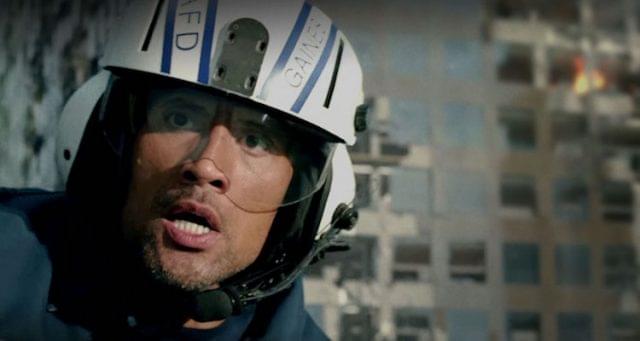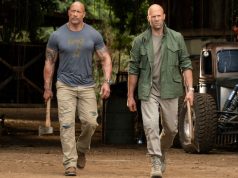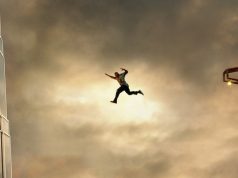
Let me tell you up front that I held my breath and gripped my armrests during most of the action scenes in “San Andreas,” just like the movie wanted me to. I had fun with it. The Rock is a high-wattage movie star, and the special effects are perilously convincing. But at the same time … here’s the thing:
In the old days, you could make an entire film about the collapse of a single skyscraper, or the destruction of the Golden Gate Bridge. Those were huge, grave events. But now that computers have made it easy and cheap (relatively speaking) to depict such catastrophes, one movie might have dozens of them, tossing off devastation casually, with all the import removed. In “San Andreas,” the Golden Gate Bridge collapses in the background of another scene. Tall metropolitan buildings, full of thousands of workers, crumble left and right, and the only time the movie ever shows any interest is if one of three specific characters happens to be in the building at the time.
Focusing on a few individuals is really the only way to make a disaster movie work, of course. It’s hard to make audiences feel an emotional investment in “the whole city” or “all of humanity.” I don’t fault (HA!) “San Andreas” for that, especially not when the people it focuses on are an appealing and chesty family consisting of Dwayne Johnson, Carla Gugino, and Alexandra Daddario.
The problem isn’t that the movie only cares about them. The problem is that THEY only seem to care about them, too. The Rock plays Ray, a Los Angeles Fire Department helicopter pilot and rescuer who’s the best of the best. Not a great employee, though. When The Big One hits L.A. and is felt in San Francisco, where his daughter, Blake (Daddario), is, Ray commandeers an LAFD chopper and flies north to rescue her himself — never mind that he and the chopper are needed here at the epicenter, and that, you know, San Francisco has a fire department too.
Along the way, Ray picks up his soon-to-be-ex-wife, Emma (Gugino), from the roof of a high-rise. She was having lunch at an upper-story restaurant and was the only person there with the good sense to get a phone call from her husband telling her to go to the roof rather than downstairs. The lunch companion who was rude dies; the waitress who was nice lives. That pattern continues throughout the film: anyone who dies after having had a speaking role will have somehow deserved it, with the exception of one person who dies heroically while saving someone else.
Most of the deaths are quite anonymous, though, and are not remarked upon. A casual glance at the massive destruction shown onscreen would suggest casualties in the hundreds of thousands; thankfully, nobody ever hazards a guess at the death toll, as this would be a serious buzzkill. Only Paul Giamatti, playing a seismologist who discovered a way to predict earthquakes exactly one scene after declaring his desire to do so, is concerned about the big picture. To Giamatti falls the thankless task of expounding all of the movie’s science and uttering lines like “We’ve got to act before it’s too late,” “God help us all,” etc. Giamatti is always good, even in hammy roles like this.
The film ends exactly as you’d expect it to, despite director Brad Peyton’s herculean efforts to introduce suspense into the matter of whether or not The Rock will save his daughter’s life. (I’ll give you a hint: Ray and Emma had another daughter who died a few years ago, in a situation much like the one Blake eventually finds herself in.) Actually, there was one unexpected moment: the introduction of a glorious American flag unfurling in the breeze, apropos of nothing, as Ray looks out over the now-calm scenes of devastation and says, “Now we rebuild.” It’s like they suddenly remembered that they’d forgotten to make the film patriotic, as disaster movies sometimes are, and crammed a flag in at the last minute.
None of which changes the fact that, as I said, I got a kick out of most of it. You can make a smart, logical disaster movie that’s also really fun (probably; I can’t think of any off the top of my head), but that’s not “San Andreas.” “San Andreas” is the dumb kind — visually well-executed, shiny and seat-rattling, and completely useless otherwise. It does the one thing it set out to do, though, and so here we are.
B (1 hr., 54 min.; )





